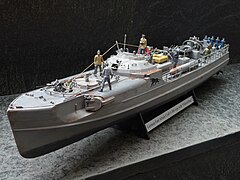Naval modeling
The Naval modelling consists of the construction of ship models to scale, existing two great currents; one for static modeling, and another for navigable modeling.
The beginnings of modeling in general go back many thousands of years, from when primitive man began to create replicas of animals and plants from his environment. In Egypt, representations of Egyptian ships dating from 2000 BC were found.
Scales
The scale represents the times in which the real ship is divided for its creation, that is, if the real ship measures 250 meters and the scale is 1:1000, it corresponds to divide the 250 meters of the ship by 1000, which gives a measure of 25 centimeters, that is, a 1:1000 scale model of a 250-meter ship measures 25 centimeters. The most common scales are 1:350 or 1:400 for larger ships and 1:700 for small ships.
Static modeling
This type of model aims to make a reduced model as similar as possible to a real ship, existing or that has existed, but trying to achieve the highest possible fidelity with respect to the original.
There are basically 2 ways to represent the ship to scale, full hull (full hull) or waterline. The first shows the complete model, both the ship's topside (what is above the waterline) and the bottom (submerged hull with propellers and rudder). In this case it is common to support the ship with some type of base or pedestal. For waterline presentations, it is normally chosen to create a base that simulates the sea, with which a diorama is produced (representation of a scene).
Static Modeling is basically for exhibition, both in personal collections and in museums. As they are not models that will be navigable, they can have a higher level of detail since they will not suffer the damage typical of their use. Many parts of these models, such as wiring, railings and other small parts are very fragile, so careless handling can damage them. They are not toys, therefore they are not designed to be used as such.
Static modeling generally requires parts created from various materials by the modeler or purchased in a kit, as well as glues, brushes and paints.
Navigable Modeling
The possibility of navigating the model prevails, although in the background, all kinds of realistic details are also added. In navigable models, it is even possible to create missile launchers with firecrackers representing the projectiles, radars and mobile cannons or chimneys that expel steam.
In navigable modeling you can choose between two types; the one that comes manufactured, such as speedboats, which can be purchased in toy stores. There is also the case of boats, motorboats and sailboats that can be manufactured, most of those that are made are usually of their own design, and made of wood, additionally the user usually introduces the necessary equipment so that they can navigate.
Additionally, there are boat preparation kits, which come ready for the parts to be assembled.
Materials
The most widespread material in naval modeling is injected plastic. Manufacturers offer boxed kits containing plastic sheets with break-away parts which are generally delivered unpainted and in a light gray base color. The international association that brings together this type of modeling is the IPMS.
Wood is generally used to create models of sailing ships made of wood like the galleon or the ship. They can be built from manufacturers' kits or from plans distributed by manufacturers or museums and creating the wooden pieces yourself by hand. The models are complemented with pieces of brass, cast iron or other metals for cannons, bow figureheads or stern decorations. Wooden modeling is one of the most admired by the general public due to the complexity of the work and the attractiveness of the sails and rigging.
Another material that is used is paper, the designers make the pieces of the boats on paper as plans but with the advantage that they already come in color to cut, fold and paste. Although most of the finished models do not obtain a higher level of presentation than the aforementioned materials, there are some firms such as GPM that produce these papermodels with an extraordinary level of detail, even managing to surpass plastic and wood, but they are designed for high-end modelers. expert paper. The strong point of paper modeling is the low cost of the kits, finding many free on the Internet such as those of the Total Navy firm. [citation required]
One of the countries with the greatest production and dissemination of paper models is Poland, which during the post-war years had restrictions on the use of plastic, which is why the creativity of Polish modelers managed to evolve this type of modeling. Other types of materials used are matchsticks, resin and polystyrene.
The so-called Scratchbuild is considered one of the most challenging challenges in naval modeling since it does not start from pre-fabricated parts but uses all kinds of materials such as fiberglass or plastic sheets, as well as metal, wire, etc.. Unlike the wood that generally represents ships that were made of that material, the scratchbuild represents steel ships.
To increase the detail of the ships to scale, there are decals, flags and photoetched parts, which are sheets of metal with parts forged in that material with a higher level of detail than plastic ones.
Collections
In almost all the naval museums in the world there are collections of scale ships, and there are also private collections of collectors who buy the ships made by other modelers. Worldwide there are 2 collections created by modelers that stand out:
- Philip Warren, an English modeler who in 65 years has made 432 ships on a 1:300 scale mainly from the Royal Navy based on matching matches.
- Erick Navas Peruvian modeler who in 20 years has made 800 warships on scale, most plastic but also with other materials.[chuckles]required]
Gallery of models
Contenido relacionado
Philosopher Stone
Raul Alfonsin
Antichton










